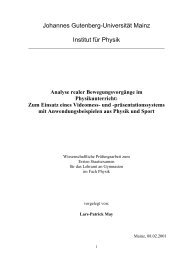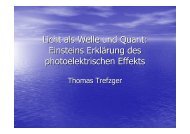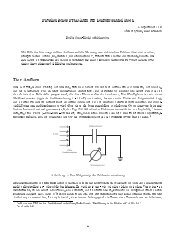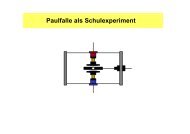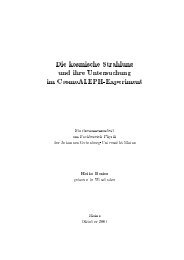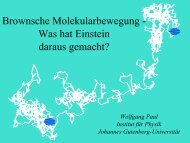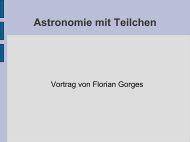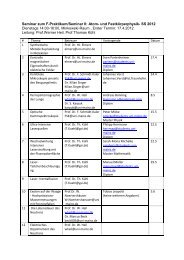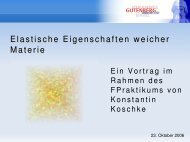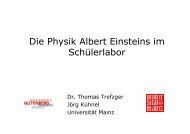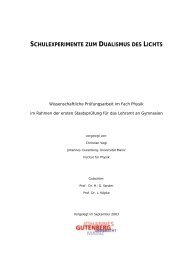Paper - Institut für Physik
Paper - Institut für Physik
Paper - Institut für Physik
Create successful ePaper yourself
Turn your PDF publications into a flip-book with our unique Google optimized e-Paper software.
milq (Munich Internet Project for Learning Quantum Mechanics)<br />
B. Schorn 1 , H.Wiesner 1<br />
1<br />
Lehrstuhl für Didaktik der <strong>Physik</strong>, LMU München, Schellingstr. 4, 80799 München,<br />
Germany<br />
milq (Munich Internet Project for Learning Quantum Mechanics) is an in-service-teacher<br />
training which uses the Internet as a medium to guide and support a learning process about the<br />
basic ideas of quantum mechanics. An essential part of this course is the information about actual<br />
topics of physical research. “milq” also offers teaching materials and hints for teaching quantum<br />
mechanics at school. In this article the structure and the contents of “milq” will be presented and<br />
the first trends in the evaluation results of this kind of in-service-teacher-training will be<br />
indicated.<br />
“milq” [1] is an example of a new method of teacher advanced training: via the Internet it<br />
is possible to take part in a in-service-teacher training, which contents can be comfortably worked<br />
on at home, at any time and by a not restricted number of participants. Therefore potential long<br />
and expensive journeys to the venue and restrictions by the limited number of participants do not<br />
arise. Further advantages are that multi-media based elements like applets, simulation programs,<br />
Interactive Screen Experiments (ISE) and small video films can be integrated immediately,<br />
because they are available at any time for use in school besides other teaching materials.<br />
A discussion about quantum mechanics at school is unavoidable, because in the meantime<br />
quantum physics is a steady and important component in the teaching and learning curricula.<br />
This, however, is more difficult than the discussion on other branches of physics: the underlying<br />
theory is very mathematical and abstract and, hence, there are partially not enough clear<br />
representations and explanations. Within the scope of studies at university a very formalistic<br />
knowledge at a mathematical high level is acquired, which serves merely as background<br />
knowledge for the implementation at school. Furthermore quantum physics is still an object of<br />
actual research and cannot be considered as a closed branch of physics. More and more<br />
experiments in this context are opening new application possibilities as for example the quantum<br />
teleportation, the quantum computer and – combined with this – also the quantum cryptography.<br />
These points are good reasons for a well-founded discussion about quantum physics in<br />
schools. The Munich draft [1], [2] has been originated on the basis of earlier papers (e.g. [3]) on<br />
learning difficulties, the problems of interpretation and its critical analysis of teaching processing<br />
in the field of quantum mechanics. In this draft the conceptual understanding of quantum<br />
mechanics is particularly ostensible. For this reason two main focuses are especially important:<br />
• quantum mechanics is fundamental different from classical physics<br />
and<br />
• the accentuation on the interpretation questions of the quantum mechanics.<br />
Since there is a general need for detailed background knowledge and processed materials<br />
concerning the standard subjects as well as for the ranges of application of quantum physics at<br />
school, the Munich draft is offered besides additional working materials and further information<br />
in form of an Internet-based in-service-teacher training.
Fig. 1. Survey of milq<br />
The offered thirteen sections are divided into a qualitative basic part (sections 1 – 7), within the<br />
conceptual understanding of quantum physics is ostensible and a quantitative advanced unit<br />
(sections 8 – 13), within the mathematical formalism of the quantum mechanics is introduced on<br />
a simple mathematical basis. The single sections consist of a teaching text, which is available as a<br />
PDF-document for printing, the on-line sides, which are formed in support of the teaching text<br />
and integrated applets and simulation programs as well as additional materials ( - and -links).<br />
The -links are containing teaching materials and hints for teaching quantum physics at school<br />
and the -links are providing background information and mathematical derivations on the single<br />
subjects of the sections. Since the contents on the single on-line sides remain clearly structured,<br />
the additional information is offered on linked sides. This leads to receive the small, manageable<br />
sections and reduces the “lost in hyperspace”-phenomenon. A possible excessive demand is<br />
thereby avoided and also extensive learning modules.<br />
The offered simulation programs (e.g. double-slit experiment, polarization filter, Mach-Zehnder<br />
interferometer) can be used immediately in school and allow an independent activity with<br />
quantum phenomena. Just because the experiments in connection with quantum physics are<br />
partially not practicable for school (on the one hand the equipment at some schools is not<br />
sufficient and on the other hand the experiments can only be performed in great labs with<br />
adequate equipment), the computer simulations can support the learning process.<br />
Besides the contents of the Munich teaching draft representations on subjects of the actual<br />
physical research and further didactical information are offered.<br />
Fig. 2. Survey of additional subjects
It is planned to complement the special subjects in “milq” with topics for example quantum<br />
cryptography and superconductivity.<br />
To receive a certification about the participation in the in-service-teacher training “milq”,<br />
a questionnaire at the end of the sections shown in figure 1 has to be filled in and sent back. The<br />
average time needed to edit a single section is between 30 minutes and one hour; this means that<br />
this kind of training is comparable to a two-day teacher advanced training.<br />
For this – as far as we know – new way of teacher training in physics questionnaires and<br />
interviews are at the moment used to evaluate the project. In particular the advantages concerning<br />
the free choice of time and place are the main reasons for the excellent acceptance of this kind of<br />
teacher training which is shown in the first results of the evaluation. Nevertheless, traditional<br />
training courses should be integrated in this Internet-based teacher advanced training about<br />
technical and special didactical contents, because in the new training the participants work<br />
isolated: important social components are getting lost. Communication and exchange –<br />
particularly about implementation in school – about the offered discussion forum does not take<br />
place, because such a type of communication is felt to be too impersonal.<br />
[1] http://www.cip.physik.uni-muenchen.de/~milq<br />
[2] Müller, R., Wiesner, H. (2002): Teaching quantum mechanics on an introductory level, AJPh 70, 200-209<br />
[3] Wiesner, H. (1988): Beiträge zur Didaktik des Unterrichts über Quantenphysik in der Oberstufe.<br />
Westarp Verlag, Essen



